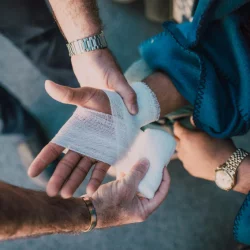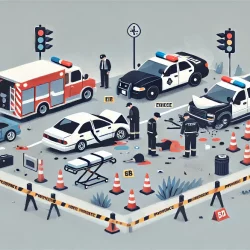Haunted Attractions: Are They Really Safe for Visitors?
Haunted attractions have become a staple of Halloween festivities, drawing thrill-seekers eager to experience the spine-chilling excitement these venues promise. From haunted houses to spooky mazes, these attractions are designed to scare and entertain. However, as the popularity of haunted attractions grows, so does the concern for visitor safety. This article delves into the various safety measures and potential risks associated with haunted attractions, aiming to answer the pressing question: Are haunted attractions really safe for visitors?
History of Haunted Attractions
The concept of haunted attractions dates back centuries, with early examples including ghost tours and haunted house exhibits. Over time, these attractions have evolved, becoming more elaborate and immersive. The commercialization of haunted attractions began in earnest in the 20th century, with theme parks and independent operators creating increasingly sophisticated experiences. Despite their long history, haunted attractions have not been without incident, with several notable accidents raising questions about their safety.
Common Safety Concerns
Several safety concerns are commonly associated with haunted attractions. Physical injuries are perhaps the most obvious risk, with visitors frequently navigating dark, confined spaces filled with obstacles designed to startle. Trips, falls, and collisions are not uncommon. Additionally, the psychological impact of these attractions can be significant, with some visitors experiencing panic attacks or heightened anxiety due to the intense scare tactics employed.
Fire hazards are another major concern. The use of special effects, such as fog machines and pyrotechnics, coupled with the often temporary nature of these setups, can create dangerous conditions. Ensuring that haunted attractions have proper fire safety measures, including clear emergency exits and fire suppression systems, is crucial.
The structural integrity of haunted attractions is also a critical factor. Many haunted houses are constructed quickly and may not always meet the highest building standards. Regular inspections and adherence to building codes are essential to prevent structural failures.
Health concerns can also arise from the use of strobe lights, fog machines, and other special effects. These can trigger seizures in individuals with epilepsy or cause respiratory issues in those with allergies or asthma. Operators must be mindful of these risks and provide appropriate warnings to visitors.
Safety Regulations and Standards
To address these concerns, various safety regulations and standards have been established. Local, state, and federal regulations govern the operation of haunted attractions, with agencies such as the Occupational Safety and Health Administration (OSHA) playing a key role in enforcing these rules. These regulations cover a wide range of safety aspects, from fire safety to structural integrity.
In addition to governmental regulations, industry standards and best practices have been developed by organizations and associations dedicated to the haunted attraction industry. These standards provide guidelines for operators to ensure the safety of their attractions and protect both visitors and staff.
Safety Measures Implemented by Haunted Attractions
To mitigate the risks associated with haunted attractions, operators implement a variety of safety measures. Staff training and preparedness are paramount. Employees are often trained in emergency response procedures and first aid to handle any incidents that may occur. Regular safety drills ensure that staff are prepared to act quickly and effectively in the event of an emergency.
Emergency response plans are a critical component of safety measures. These plans outline procedures for evacuating visitors, contacting emergency services, and managing crises. Clear and visible safety equipment and signage, such as fire extinguishers and exit signs, are essential for guiding visitors to safety.
Visitor guidelines and rules are also an important aspect of safety measures. Operators provide instructions to visitors on how to navigate the attraction safely, including warnings about potential hazards and behavior expectations. These guidelines help ensure that visitors are aware of the risks and know how to avoid them.
Technology plays an increasingly important role in enhancing safety. Surveillance cameras allow operators to monitor the attraction in real-time, identifying potential issues before they escalate. Communication devices enable staff to stay in constant contact, ensuring a coordinated response to any incidents.
Case Studies
Examining real-world examples can provide valuable insights into the safety of haunted attractions. One notable case is Halloween Horror Nights at Universal Studios, which has a strong safety record thanks to its rigorous safety protocols. The attraction employs a large security team, conducts regular safety drills, and uses advanced technology to monitor visitor safety. Another example is the 2014 incident at the Haunted Castle in New Jersey, where a fire tragically resulted in several fatalities. This incident highlighted the importance of fire safety measures and led to stricter regulations and improved safety standards across the industry.
Expert Opinions
To gain a deeper understanding of the safety measures in haunted attractions, we consulted with safety experts and operators. According to Dr. Emily Johnson, a safety consultant specializing in entertainment venues, "The key to ensuring safety in haunted attractions lies in thorough planning and regular training. Operators must be proactive in identifying potential hazards and implementing measures to mitigate them." Haunted attraction operator Mark Stevens adds, "We take safety very seriously. From the design phase to daily operations, every aspect of our attraction is scrutinized to ensure it meets the highest safety standards. Our staff undergoes continuous training to handle any situation that may arise."
Visitor Responsibilities
While operators play a crucial role in ensuring safety, visitors also have responsibilities. To ensure their own safety, visitors should adhere to the guidelines and rules provided by the attraction. This includes staying on designated paths, not touching props or actors, and following instructions from staff. Visitors with specific health concerns, such as epilepsy or asthma, should take extra precautions and avoid attractions that may trigger their conditions. It's also advisable to attend haunted attractions with a group, as having companions can provide additional support and help in case of an emergency.
Conclusion
Haunted attractions offer a unique and thrilling experience, but safety should always be a top priority. While there are inherent risks associated with these attractions, a combination of stringent safety regulations, proactive measures by operators, and responsible behavior by visitors can significantly reduce these risks. By staying informed and cautious, visitors can enjoy the spine-chilling excitement of haunted attractions without compromising their safety. For more information on staying safe in haunted attractions, check out this are haunted houses safe guide.
More to Read:
Previous Posts:




